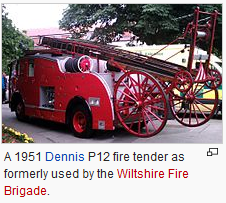History of firefighting
Knox Automobile produced the world's first modern fire engine in 1905.
A 1951 Dennis P12 fire tender as formerly used by the Wiltshire Fire Brigade.
A Fire and Rescue NSW truck in 2008
Ancient Rome
The earliest known fire department was formed in Ancient Rome by Egnatius Rufus who used his slaves to provide a free fire service.[2] These men fought fires using bucket chains and also patrolled the streets with the authority to impose corporal punishment upon those who violated fire-prevention codes. The Emperor Augustus established a public fire department in 24 BCE, composed of 600 slaves distributed amongst seven fire stations in Rome.[3]
1600s and 1700s: Property Insurance Companies, Public Funding, and Improved Firefighting Technology
Fire departments were again formed by property insurance companies beginning in the 17th century after the Great Fire of London in 1666. The first insurance brigades were established the following year.[4] Others began to realize that a lot of money could be made from this practice, and ten more insurance companies set up in London before 1832: The Alliance, Atlas, Globe, Imperial, London, Protector, Royal Exchange, Sun Union and Westminster.[5] Each company had its own fire mark, a durable plaque that would be affixed to the building exterior. A company's fire brigade would not extinguish a burning building if it did not have the correct fire mark.[6]
Amsterdam also had a sophisticated firefighting system in the late 17th century, under the direction of artist Jan van der Heyden, who had improved the designs of both fire hoses and fire pumps.[7]
The city of Boston, Massachusetts, established America's first publicly funded, paid fire department in 1679.[8][9] Fire insurance made its debut in the American colonies in South Carolina in 1736, but it was Benjamin Franklin who imported the London model of insurance. He established the colonies' first fire insurance company in Philadelphia named the Philadelphia Contributionship,[4] as well as its associated Union Volunteer Fire Company, which was an unpaid (volunteer) company.[10]
In 1754,[11] Halifax, Nova Scotia established the Halifax Regional Fire and Emergency, which is today Canada's oldest fire department.
In 1773, the city of Petersburg, Virginia established one of the first fire departments in the United States[12][13] and it was also made up of unpaid volunteers[14]
1800s: Fire Companies and Municipal Fire Departments
In the 19th century, the practice of fire brigades refusing to put out fires in buildings that were uninsured led to the demand of central command for fire companies.[citation needed] Cities began to form their own fire departments as a civil service to the public, obliging private fire companies to shut down, many merging their fire stations into the city's fire department. In 1833, London's ten independent brigades all merged to form the London Fire Engine Establishment (LFEE), with James Braidwood as the Chief Officer.[15] Braidwood had previously been the fire chief in Edinburgh, where the world's first municipal fire service was founded in 1824, and he is now regarded, along with Van der Heyden, as one of founders of modern firefighting.[7] The LFEE then was incorporated into the city's Metropolitan Fire Brigade in 1865 under Eyre Massey Shaw.
Established in 1853, the Cincinnati Fire Department is the oldest paid fully professional municipal fire department in the United States.[16]
In 1879, Notre Dame University established the first University-based fire department in the United States [17]
1900s: Motorized Fire Departments
In 1906, the first motorized fire department was organized in Springfield, Massachusetts, after Knox Automobile of Springfield produced the first modern fire engine one year earlier.[18]
Emergency Medical Services
In many countries or regions (e.g. United States, Canada, Japan), fire departments are often responsible for providing emergency medical services. Many firefighters are cross-trained as medical first responders, emergency medical technicians, or paramedics. Some services act only as "first responders" to medical emergencies, stabilizing the victim until an ambulance can arrive. Many fire departments also operate ambulance services.


